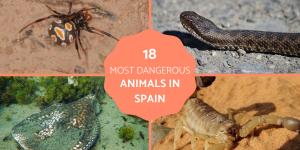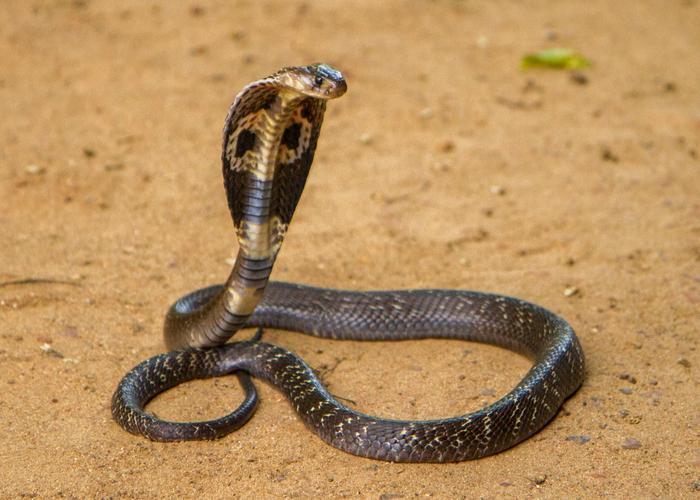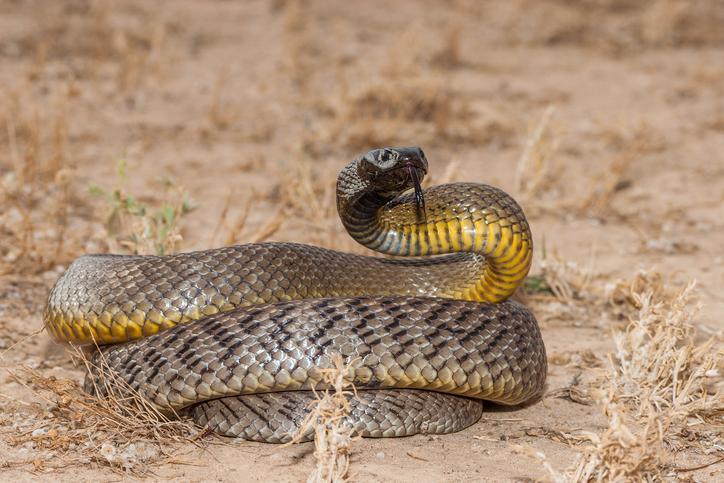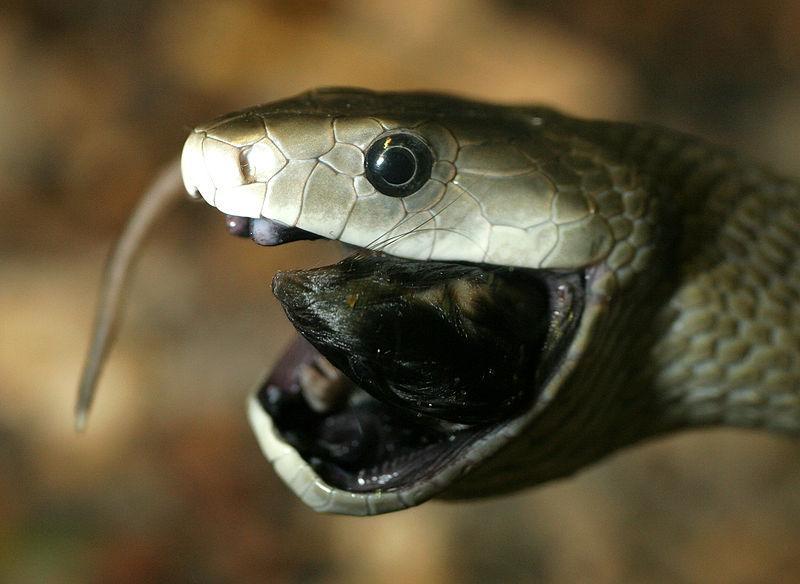The 8 Most Dangerous Reptiles in the World


All animals attract attention for various reasons, their physical appearance being perhaps the most common. It is a primal response we use as a way to protect ourselves and know who is friend or foe. Reptiles are one of the most feared in the animal kingdom as they encompass some of the deadliest creatures on the planet. This is why even harmless reptiles we keep as pets induce a certain amount of fear in many people. With crocodiles and their powerful jaws or poisonous snakes and their deadly venom, it is understandable why some may be wary.
However, we need to understand that no animal is cruel or bad by nature. They are simply trying to survive in there different environments in which they find themselves, hunting for food or defending against perceived predators. If a human encounters these animals, there may be a lethal end. AnimalWised brings you the 8 most dangerous reptiles in the world with pictures and interesting facts, so you will know to respect their boundaries if you are ever unfortunate enough to meet face to face.
1. King cobra (Ophiophagus hannah)
We start with some reptilian royalty. The King Cobra has a powerful venom which is used to paralyze its prey before ingesting it. It is one of the most poisonous snakes in the world, its venom being complex and having a very fast cardiotoxic and neurotoxic action. This means that once its prey has been dosed, it will directly affect the heart and central nervous system. The recipient is first paralyzed, followed by a steady shutting down of all bodily functions.
King cobras are native to Southeast Asia, India and Southern China. Its thin body can exceed 5 meters in length and is considered the largest of the poisonous snakes. To distinguish from other snake species, we can see they have a a hood which extends when they are in a defensive position. They also have two large ‘occipitals’ which are large individual scales on the back of their head. Only the King Cobra has this particular type of scale pattern.
Find out more dangerous Asian animals with our guide to the deadliest reptiles in India.

2. Taipan snakes
These snakes are from the taipan genus of snakes, of which the inland taipan (Oxyuranus microlepidotus) is the most venomous snake in the world. They originate in Oceania and they vie for the position of most dangerous rpetile with the King Cobra. The problem is how we define ‘deadliest’. Do we mean the one which has killed the most people? Or are they deadliest because of the ease with which they can kill you? The inland taipan is considered the most poisonous with a venom 400 times more deadly than the rattlesnake.
The inland taipan inhabits the black soiled inland areas of Australia, but there are also coastal taipans which are similarly deadly. While many people want to protect against this deadliness, like all Australian snakes, there are laws in place to protect them from us. How deadly they are also depends on how much venom actually goes into the bloodstream, but even the smallest drop of taipan venom can be potentially lethal.

3. Russell's viper (Daboia russelii)
The Russell's viper is sometimes known as the chain viper and their reason for being on our most deadly list is due to the number of incidents which have been recorded against humans. They don't necessarily go looking for trouble, but if they feel like they are being cornered or in danger, they will become particularly aggressive.
They are native to India, Taiwan and southern China, making them one of the deadliest animals in Asia. Despite their small size (they usually measure between 1 and 1.5 m), this viper stands out for its strength, agility and robustness. Some features which distinguish it from other snakes are their large nasal holes, a bent snout, a triangular head and a prominent scale on the front of their face. Their hiss is believed to be the loudest of all snakes and their deadliness is partly due to their tenacity when pursing their prey.

4. Black mamba (Dendroaspis polylepis)
Originating on the African continent, the black mamba is also one of the most poisonous animals in the world and perhaps the most deadly. Although their skin is olive green or shades of grey, they derive their name from the inside of their mouth which is totally black. It is a large snake with a length of up to 4 meters, but despite their size they have extreme agility. It is the snake most feared b y the population of Africa, partly as it is known as a territorial snake. This means they can be very fearsome when cornered, although, like most snakes, they don't go looking for trouble with humans.
When attacking they will give repeated strikes which deliver lots of very strong venom. Their size means they can also reach the human head, not just the lower extremities. With the second most deadly venom in the world, their large size and aggressiveness, the reasons for being considered the most deadly snake are understandable. Mortality is 100% if a bite goes untreated, but many still die even with treatment. Their venom is so strong and of such large quantity that they a person may need up to 30 vials of antivenom to survive. Death can occur after 15 minutes of receiving a bite.

5. Saltwater crocodile (Crocodylus porosus)
The saltwater crocodile, also known as the marine crocodile, is the largest known reptile alive today. Adult males can measure up to 7 m in length and weigh up to 1500 kg (3300 lb). Females are about half the size, but they are still big reptiles.
Their population mainly live in the marshy lands of Australia, Indochina, Malaysia, the Philippines, Indonesia, Mew Guinea, India, Sri Lanka and Bangladesh. However, since they are such excellent swimmers, they can survive in open waters and have been known to migrate to the coasts of French Polynesia and the Solomon Islands.
In their habitat, these crocodiles are superpredators with the strongest bite of any reptile and certainly up there in the whole animal kingdom. In general, they behave like opportunistic hunters, finding prey by hiding and waiting for it to come along. Often this is done at the banks of rivers, waiting for an animal to drink and then attacking. Because they are so opportunistic, they will not hesitate to attack a human doing the same. This has lead to numerous attacks per year and cementing their place on our list of deadliest reptiles in the world.

6. Black caiman (Melanosuchus niger)
The black caiman is one of the largest reptiles in the world. Caiman are neither alligators or crocodiles, but they come from very similar families. Their body can reach 6 meters in length and is known for its dark coloration. They are a vulnerable species, but fortunately they are not hunted as much as they have been previously. Unfortunately, this is likely because other types of caiman and their markings have become more popular.
These huge animals are native to South America and live mainly in the fresh waters of the amazon. Along with animals such as the jaguar and anaconda, they are considered an apex predator. This means they are either at the top or vying for the top position on the food chain. Their diet ranges from small mammals, birds and fish to larger animals like the monkey, capybara or wild boar.
Besides being an excellent swimmer, the black caiman is also very smart and skilled at attacking their prey. They are relentless. If their powerful jaws latch on to you, it is near impossible to get them off. This makes them one of the most dangerous reptiles in the world, but is particularly feared in the Amazon.
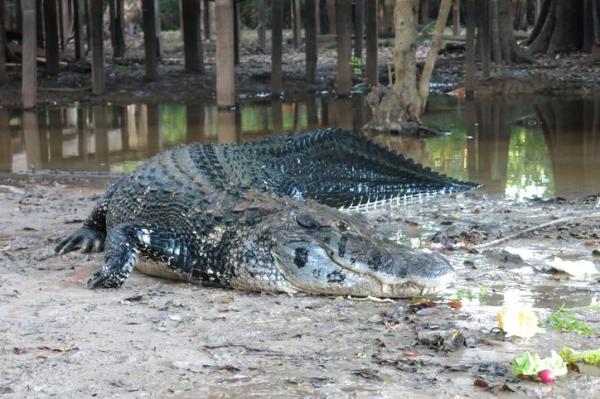
7. Komodo dragon (Varanus komodoensis)
The Komodo dragon is almost as feared as it is famous, weighing up to 190 lb and reaching 3 m in length. They are the largest species of lizard known today being endemic to the volcanic islands of Indonesia.
Komodo dragons are predators par excellence and are top of the food chain in their natural habitat. Their hunting technique consists of immobilizing their prey with toxins present in their saliva. They then use their sharp teeth to then feed. The poison is not there to kill their prey, but to incapacitate it and prevent them from escaping.
The poison has a an anticoagulant and hypotensive action. What this means is that the toxins cause the victim's blood to become thinner and leave the body more quickly, while the blood pressure drops and the body ceases function. This state of shock prevents escape. The effect on blood was, until relatively recently, thought to be due to old food residing in the mouth. This food was thought to breed bacteria and result in blood poisoning.
This means that the Komodo dragon is a particularly dangerous threat. However, attacks on humans by Komodo dragons are relatively rare. Humans do not usually live in the same food chain and may not see them as desirous. However, when they feel threatened or perceive an invader to be in their environment, this giant reptile can attack to guarantee their survival.

8. Alligator snapping turtle (Macrochelys temminckii)
Few people might think of the turtle as a dangerous reptile, especially when compared with poisonous snakes or giant crocodiles. However, these alligator snapping turtles are not to be messed with. They have an imposing presence, a powerful bite and have a somewhat fierce and aggressive nature (although they are not as aggressive as some other snapping turtles). Its natural habitat consists of in and around the Mississippi river in the USA.
Unlike many turtles which have a docile demeanor and inspire a sense of cuteness more than fear, alligator snapping turtles are intimidating looking creatures. It most striking features are their sharp front beak, large robust head shell with pointed designs, scaly skin and long tail which can sometimes be the same length of the animal's body.
Another curiosity about alligator turtles is the clever technique applied to attract prey. This affirms their place as an aquatic superpredator. The turtle uses its red vermiform tongue to simulate the movement of worms. The fish swim along and are tricked into thinking this illusion is an actual worm. They then use their powerful bite to snap down and eat the fish.
Fortunately for us, these turtles are not known to kill many humans. However, this does not mean they don't have the potential to be deadly. A lake in Southern Germany was drained to find a turtle which snapped at a boy who was swimming by, snapping his tendon in the process[1]. If this was in the neck or artery, then the boy wouldn't have been so fortunate.
Find out more with our article on the different types of freshwater turtle.

If you want to read similar articles to The 8 Most Dangerous Reptiles in the World, we recommend you visit our Facts about the animal kingdom category.
1. CBC News. (2013). Germans hunt snapping turtle after reported attack on boy. Retrieved from:
https://www.cbc.ca/news/world/germans-hunt-snapping-turtle-after-reported-attack-on-boy-1.1330393


